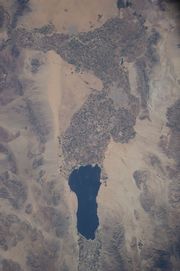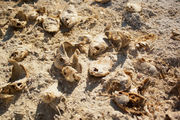The Salton Sea: Water Scarcity in Southern California
| Geolocation: | 33° 13' 54.8518", -115° 42' 32.6905" |
|---|---|
| Total Population | 1.51,500,000 millionmillion |
| Total Area | 21,70021,700 km² 8,378.37 mi² km2 |
| Climate Descriptors | Arid/desert (Köppen B-type) |
| Predominent Land Use Descriptors | agricultural- cropland and pasture, conservation lands |
| Important Uses of Water | Agriculture or Irrigation, Domestic/Urban Supply, Other Ecological Services |
Contents
[hide]Summary
The Salton Sea is located in the Imperial Valley of the Colorado Desert in southern California. It was accidentally created in 1905 when a canal diverting water from the Colorado River for agriculture failed; the inundation from the river into the Salton Sink lasted for 18 months before engineers could repair the breach, resulting in the creation of the largest lake in the state. Since its formation, the Sea has been maintained primarily by agricultural runoff and it has added tremendous biological, social and economic value to the surrounding area. Entire communities were formed around the sea and it is a popular recreation destination. In addition, it is a critical stop for migrating birds on the Pacific and Central Flyways. The Quantification Settlement Agreement, signed in 2003 to address California’s rising urban water demand and overuse of the Colorado River, resulted in an unclear future for the Salton Sea as the water allotments of the surrounding farmland were transferred to coastal southern California, reducing the inflow to the Sea. Current inaction in the California Legislature has resulted in an uncertain future for the integrity of the Salton Sea. Although stakeholders have participated in the many agreements surrounding this case and have formed joint power authorities, there is a lack of enforceable responsibilities that has resulted in stalled decision making. The enabling conditions for solving this complex transboundary water problem are present and many creative solutions have been proposed. However, the ball currently lies in the court of the California Legislature; without an imminent decision for a restoration plan, the Salton Sea will begin to deteriorate exponentially in 2017. The consequences of inaction are far reaching with effects on human health, socio-economic factors, and important ecosystems and large
populations of animals.
Natural, Historic, Economic, Regional, and Political Framework
Formation of the Salton Sea and its consequences
The Salton Basin, located about 130 miles southeast of Los Angeles, California is a large geological depression in the Imperial Valley of the Colorado Desert that sits two hundred feet below sea level. As one arm of the lower Colorado River delta, throughout history and with the changing course of the Colorado River, the depression was intermittently and repeatedly filled (Glenn et al, 2009; Delfino, 2006). In the late 1800s, under the Homestead and Desert Acts, settlers arrived, cultivating the sediment rich fertile land and forming cities, such as Imperial, California (Forsman, 2014). In order to divert water from the Colorado River to irrigate the farmland, the California Development Company constructed the Imperial Canal in 1902 (Forsman, 2014). Strong flooding in the winter of 1905 caused the canal to breach and the subsequent inundation of the Salton Basin continued uncontrolled for 18 months, leading to the loss of farms, homes and railroad lines and, ultimately, resulted in the formation of the modern Salton Sea (Delfino, 2006; Forsman, 2014).
By the time the flooding ceased, the Sea covered 400 square miles and was over 80 feet deep (Horowitz, 2012). In the early 1900s, the Salton Sea was primarily fresh water; it wasn’t long before it was stocked with fish and commercial fisheries, residential, recreational and retirement communities developed along the shores (Horowitz, 2012). In order to maintain freshwater inflow to the Salton Sea, agricultural runoff from the surrounding farmlands were rerouted with 35% of the irrigation water applied to the fields in the Imperial and Coachella Valley entering the Sea (Glenn et al, 1999). Due to the heavy soils in the basin, special irrigation practices that carry away damaging salts from the crop roots were employed; the salts, in addition to fertilizer run off, pesticides and other contaminants all flow to the Sea (Glenn et al., 1999).More than 1.3 million acre feet of water, evaporates from the Salton Sea each year (Delfino, 2006). As evaporation extracts only water, the remaining salts and chemicals become more concentrated. Because of this, the salinity level in the Salton Sea has been steadily rising and the salt levels are currently one and a half times that of the ocean (Case et al., 2013). The increased salinity resulted in periodic massive fish kills (and associated foul odors) and, combined with the heat, most people abandoned the area (Horowitz, 2012).
Astounding numbers of birds visit the Salton Sea each year and it is one of the most important locations in North America for migrants on the Pacific Flyway. During parts of the year, the Sea supports about 80% of the western American white pelican population, 90% of North America’s population of eared grebes, and provides breeding grounds for 40% of the endangered Yuma clapper rail (Delfino, 2006). The importance of the Salton Sea to bird populations was recognized early on, and in 1930, a National Wildlife Refuge was established along part of its southern border. The level of protection associated with the Refuge established broad security for many of the seemingly non-economic ecosystem services (e.g., wetlands, bird habitat) that may have vanished with the expansion of the Imperial Valley (McLaren, 2015).
While the Salton Sea provides critical feeding, resting and breeding habitat to birds, it also poses potential threats. Infectious or toxic disease in the sediments can be spread to birds by consuming fish or invertebrates feeding from the sediments. In one instance 150,000 birds and over a million fish died in a single year; large fish kills (from parasites or other infections) attract large numbers of birds that are then susceptible to disease outbreaks (Glenn et al, 1999). Additionally, invertebrates living in the Sea accumulate the ever-concentrating selenium, and this is biomagnified up the food chain from fish to birds with some fish exceeding the critical level of 12 ug/g for reproductive success and 40% of the birds evaluated in the Imperial Valley exceeding the 30 ug/g threshold associated with biological risk (Glenn et al., 1999).
California water use
Historically, California has repeatedly exceeded its annual interstate allotment of 4.4 million acre-feet from the Colorado River; as Arizona and Nevada became more populated and began to realize their full apportionments, California could no longer overdraw from the river (Case et al., 2013). In 1997, the Secretary of the Interior instructed California to develop a plan to reduce its reliance on the Colorado River or face immediate reduction to the 4.4 million acre-foot level (Forsman, 2014). In October 2003, a series of agreements, known as the Quantification Settlement Agreement (QSA), were made between the Federal Government, State of California, Imperial Irrigation District (IID), Metropolitan Water District of Southern California, Coachella Valley Water District (CVWD), and San Diego County Water Authority (SDCWD). Part of this agreement included the transfer of a portion of the IID’s water allotment used for agricultural irrigation in the Salton Basin to the San Diego Water Authority meet San Diego’s increased urban water demand (Case et al., 2013).
Current Status of the Salton Sea
The Salton Sea is currently receiving supplemental water from the IID to mitigate against the water transfer deal’s reduced inflow. After 2017, the IID is no longer legally required to supply mitigation water to the Sea and its fate remains uncertain.
In order to develop air quality management plans and administer funding for environmental mitigation requirements, the QSA established a Joint Powers Authority (JPA) comprised of the California Department of Fish and Wildlife (DFW), CVWD, IID, and SDCWA. Though, importantly, these plans and mitigations are distinct from the promised full-scale restoration (Cohen, 2014). The three water districts in the JPA are responsible for the first $133 million in environmental mitigation costs and the State of California is responsible for the excess costs; unfortunately, there is no specification in the QSA JPA funding agreement that dictates when state funding responsibility is triggered and California has yet to establish when it expects to begin payments (Cohen, 2014). The high cost of the plans proposed in Salton Sea Ecosystem Restoration Study have been to blame for the deferred action by the State of California to implement a restoration plan even though studies have shown that the cost of inaction (environmental, socioeconomic, health) is significantly higher (Cohen, 2014).
In anticipation of the Legislature making a decision, CDFW, the US Bureau of Reclamation and the US Geological Survey (USGS) established a team to develop a monitoring and assessment plan (MAP). The MAP serves a guide to for data collection, analysis, management, and reporting to inform management decisions for the Salton Sea ecosystems (Case et al., 2013). In addition to biological resources monitoring, the plan includes hydrology and water quality monitoring, air quality monitoring, and socioeconomic monitoring.
One of the biggest challenges that faces the management and restoration of the Salton Sea is the uncertainty and emergence that results from the interactions of the elements of the system. Since emergent properties rely on the interrelation and interaction between various elements and agents in a system, they are often unpredictable as to when and on what scale they will arise and there is no simple relationship between them (Allen, 2014; Ramalingam et al., 2008). Ramalingam and colleagues state that in order to maximize the adaptiveness of a system, space for emergence must exist and they advise that over-controlling is not successful with complex systems (2008).
Many projections have been made about the future of the physical properties of the sea: evaporation, salinity levels, elevation, and exposed sea bed and how these will translate into environmental and health consequences. For example, by 2030 the lake is expected to triple in salinity, decrease in volume by 60% and expose 100 square miles of lakebed dust (Cohen, 2014). However, predictions are contingent upon the parameters of the models used to generate them and it is uncertain how accurately the parameters used reflect the future. For example, continuation (or even relief) of California’s drought, climate change, or changes in California water policy for residential or farm use would affect these predictions. One promising feature about the Salton Sea case is the formation of the QSA JPA, a body that will both monitor the adverse environmental changes (especially toxic dust) resulting from the shrinking Sea and develop and implement mitigation plans.
Other groups have also been created with the priority of devising plans for the restoration of the Salton Sea. One such group, the Salton Sea Authority (SSA), is composed of the local water districts and counties, and the Torres Martinez Desert Cahuilla Indians. The SSA is a Joint Powers Authority that was formed in 1993 by the State of California for ensuring the beneficial uses of the Salton Sea.
Issues and Stakeholders
Water scarcity and overuse due to population growth
NSPD: Water Quantity, Ecosystems
Stakeholder Types: Sovereign state/national/federal government, Environmental interest, Community or organized citizens
The QSA was developed and implemented because of the increasing populations in California and neighboring states. California was repeatedly overusing their share from the Colorado River to meet the demand of the growing population in the southern parts of the state. Population growth and water scarcity were driving factors for the creation of the QSA.
The water transfer arrangements made in the QSA are potentially highly problematic for the maintenance of the Salton Sea as it is sustained almost entirely through agricultural runoff from the Imperial Valley. One of the water transfer deals included in the agreement involves 400,000 acre-feet of water being transferred from agricultural areas in the Imperial Valley to the coast of southern California, effectively reducing the inflow to the Salton Sea by 360,000 fewer acre-feet per year (Forsman, 2014). Although the water scarcity issue has been temporarily resolved for the residents of urban southern California, the issue has been shifted east to the Imperial Valley. To mitigate for the loss of agricultural runoff, IID is required to replenish the Salton Sea with about 32 billion gallons of water per year for the first 15 years of the agreement- after which they are no longer legally required to supplement the Sea (Cohen, 2014).Uncertain restoration plan
NSPD: Water Quality, Ecosystems, Governance
Stakeholder Types: Sovereign state/national/federal government, Local Government, Non-legislative governmental agency, Environmental interest, Community or organized citizens, Cultural Interest
Decreasing water quality
NSPD: Water Quality, Values and Norms
Stakeholder Types: Sovereign state/national/federal government, Environmental interest, Community or organized citizens
Decreasing air quality and toxic dust
NSPD: Ecosystems, Values and Norms
Stakeholder Types: Sovereign state/national/federal government, Environmental interest, Community or organized citizens
Analysis, Synthesis, and Insight
Individuals may add their own Analysis, Synthesis, and Insight (ASI) to a case. ASI sub-articles are protected, so that each contributor retains authorship and control of their own content. Edit the case to add your own ASI.
Learn moreNo ASI articles have been added yet for this case
Key Questions
no description entered
| Area | 21,700 km² (8,378.37 mi²) + |
| Climate | Arid/desert (Köppen B-type) + |
| Geolocation | 33° 13' 54.8518", -115° 42' 32.6905"Latitude: 33.2319032694 Longitude: -115.709080696 + |
| Issue | Water scarcity and overuse due to population growth +, Uncertain restoration plan +, Decreasing water quality + and Decreasing air quality and toxic dust + |
| Land Use | agricultural- cropland and pasture + and conservation lands + |
| NSPD | Water Quantity +, Ecosystems +, Water Quality +, Governance + and Values and Norms + |
| Population | 1,500,000 million + |
| Stakeholder Type | Sovereign state/national/federal government +, Environmental interest +, Community or organized citizens +, Local Government +, Non-legislative governmental agency + and Cultural Interest + |
| Water Use | Agriculture or Irrigation +, Domestic/Urban Supply + and Other Ecological Services + |
| Has subobjectThis property is a special property in this wiki. | The Salton Sea: Water Scarcity in Southern California + |
 There are no
There are no 






